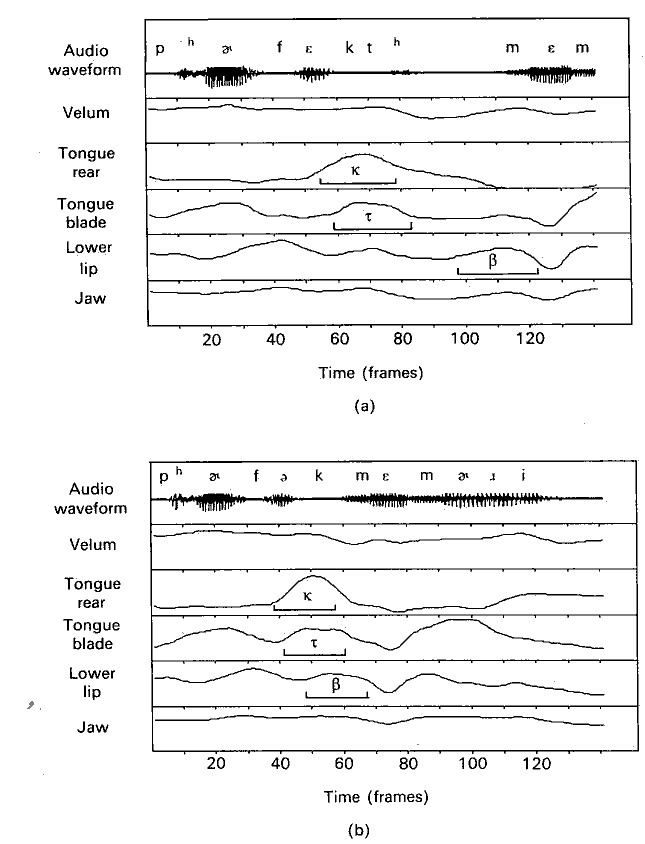1. Segmental vs. parametric views of speech
In studying the IPA alphabet, we may become so focussed on the linear sequence of consonants and vowels that we forget the fundamental fact that speech is produced by six independently-controlled organs (lungs, larynx, jaw, velum, tongue and lips) all moving simultaneously and continuously.

2. Pitch, tone and intonation
Pitch
refers to the perception of relative frequency (e.g. perceptually
high-pitched or low-pitched) of the vibrating vocal cords.
Intonation refers to the rise and fall of voice pitch over entire phrases and sentences, as in English:

3.
Terminology.
For this reason, intonation is sometimes called a supra-segmental
feature. This
terminology implies that phonetic and phonological features can be
separated into two subsets: segmental and suprasegmental features.
This
is not really correct, as we shall soon see. For this reason, I
prefer
to avoid the term "suprasegmental". Instead, I shall talk about the
prosodic function of
features.
Almost any feature can be used prosodically or segmentally,
depending
on the language.
In English, we also use pitch (in
conjunction with other features) to distinguish a few pairs of
words;
e.g. DEfect (n.) vs. deFECT.
It is quite common for pitch and
stress to be closely related. In some languages, in fact, pitch
seems
to play a role that is rather like stress in English: these are
often
referred to as pitch-accent
languages. E.g. Croatian:
| Long rising | Short falling | |||||||
| ʋǐːle | vile | ʻfairiesʼ | ʋîle | vile | ʻhayforkʼ | |||
| dǔːɡa | duga | ʻrainbowʼ | dûga | duga | ʻstaveʼ | |||
Tone refers to significant (i.e.
meaningful,
constrastive, phonemic) constrasts between words signalled by pitch
differences.
Tone may be lexical, as
in Mandarin Chinese:
Or grammatical
tone, as in many African languages, e.g.
Edo:
| Tense | Monosyllabic verbs | Disyllabic verbs |
| Timeless | [ì mà] ʻI showʼ | [ì hrùlè] ʻI runʼ |
| Continuous | [í mà] ʻI am showingʼ | [í hrùlé] ʻI am runningʼ |
| Past | [ì má] ʻI showedʼ | [ì hrúlè] ʻI ranʼ |
However, there may also be non-pitch aspects of tone. Lexical tones are often related to durational, phonatory and vowel quality distinctions as well as frequency distinctions. For example, Mandarin Chinese tone 3 (low rise) is long with creaky voice, Hunanese tone 2 has breathy or chesty voice. Tibetan tone 1 words have voiceless initial consonants whereas tone 2 words have voiced beginnings. Long vowels in tone 4 or 5 open syllables in Thai are checked by a final glottal stop.
All of these variations in pitch require the tension of the vocal cords to be adjusted up and down at the same time as the other articulators are moving, as in Browman and Goldstein's diagram in section 1 above.4. What else can be a prosody?
Virtually anything!
4.1.
Laryngeal features
In addition to tone and intonation, several other laryngeal features are prosodic in some languages. In Cœur d'Alène, a dying Salishan language spoken in northern Idaho by few speakers ("less than a handful" in 1966), glottalization (probably creaky voice, glottal stops and glottalic consonants) is used as a diminutive morpheme:
| mar-marím-EntEm-ilts | vs. | m̰-m̰ar̰-m̰ar̰ím-En̰tem̰-il̰ts |
| \___________________/ | \__________________________/ | |
| not glottalized | glottalized | |
| ʻthey were treated one by oneʼ | ʻthey little ones were treated one by oneʼ |
A complex of creaky voice, pitch and
loudness in Danish (stød)
distinguishes words in a way that parallels the use of contrastive
tones in Swedish or Norwegian, e.g. [bœn] ʻbeansʼ vs. [bœnʔ],
or [thɒŋgn̩] ʻthe thoughtʼ vs. [thɒŋʔgn̩].
(See Laver 1994 and Grønnum 1998 for further examples.) Although
I have transcribed these
using a glottal stop symbol, the glottalization is more dispersed, and
may involve creaky voiced vowel, creaky voiced sonorant consonants,
falling pitch, and glottal closure. It is therefore usually analysed
as
a prosodic feature, rather than a segmental feature.
Fischer-Jørgensen (1987) is a very thorough study (part of it
conducted here in the Oxford Phonetics Laboratory in 1981! A copy is
in the lab library.)
Voicing assimilation is another
(perhaps less spectacular) example of a feature not staying nicely
confined within a segment. For example, in Russian,
there is a maximum of
1 voicing distinction in consonant clusters. A cluster takes on the
voicing of the last consonant in the sequence, without regard to
boundaries:
| Morphemic boundary: | /gorod+k+a/ | |
[gorotka] | ʻlittle townʼ |
| Clitic boundary: | /mtsensk# bi/ | |
[mtsenzgbɨ] | ʻif Mcenskʼ |
| Word boundary: | /mtsensk## bil/ | |
[mtsenzgbɨl] | ʻit was Mcenskʼ |
Sonorants e.g. [m] are not
distinctively voiced, and they are transparent
to voicing assimilation:
| iz # mtsensk+a | |
[is mtsenska] | ʻfrom Mcenskʼ |
| ot # mzd+i | [od mzdɨ] | ʻfrom the bribeʼ |
Some French examples:
| anticipation of [+voice]: | |
anticipation of [-voice]: |
|
je passe vite [paz vit]
|
chemin de fer [t fɛːʁ]
|
|
|
la tête droit [tɛd dʁwat]
|
coup de pied [ku t pje]
|
|
|
avec vous [avɛg vu]
|
esprit de corps [ɛspʁi
t kɔːʁ]
|
|
|
place d'armes [plaz daʁm]
|
tout de suite [tu t sɥit]
|
|
|
rez-de-chaussée [ʁe
t ʃose]
|
4.2. Velum movement
| 3rd person possessives (non-nasal) |
1st person possessives (nasal) |
|
| eˈmoʔu ʻhis wordʼ | ẽˈmõʔũ ʻmy wordʼ | |
| ˈajo ʻhis brotherʼ | ˈãj̃õ ʻmy brotherʼ | |
| ˈowoku ʻhis houseʼ | ˈõw̃õŋgu ʻmy houseʼ |
Sundanese
(Austronesian, W. Java) (Robins 1957):
ɲaian [ɲãĩãn],
ʻto wetʼ
miasih [mĩʔãsih], ʻto loveʼ
kumaha [kumãhã], ʻhow?ʼ
4.3.
Tongue root prosodies
4.3.1.
Spread
of velo-pharyngealization in
Tashlhiyt Berber.
This language
(like various other Afroasiatic languages, such as Arabic)
has a
contrast between pharyngealized
and non-pharyngealized coronal consonants, as well as some
pharyngeal
consonants. In words containing these consonants, entire
syllables or
even the whole word becomes pharyngealized, as you can hear
from these
audio clips:
4.3.2. [ATR] harmony
In a number of languages of West
Africa, a particular pattern of vowel harmony is found in which the
vowels fall into two sets: more advanced and higher vowels {i, e, o,
u}
and correspondingly less advanced and lower {ɪ, ɛ, ɔ, ʊ}.
[a] is
typically "neutral", and can co-occur in words with vowels of either
set. In the more advanced and higher vowels, the tongue root has been
found to be more advanced, and hence they are given the feature
[+Advanced Tongue Root] or [+ATR]: the non-advanced vowels are
consequently labelled [-ATR]. See Laver (1994: 289-291) and references
therein, and Tiede (1996) for MRI images of Akan [i] vs. [I].
The
vowel system of Ega (Kwa, Côte d'Ivoire) (Connell,
Ahoua and Gibbon 2002) is quite typical:
| High, [+ATR] |
i | u |
||||
| High, [-ATR] | I | ʊ | ||||
| Mid, [+ATR] | e | o |
||||
| Mid, [-ATR] | ɛ | ɔ | ||||
| Low |
a |
Examples of words containing vowels in
the two sets (note that Ega also
has tones, not transcribed here):
| [+ATR] |
[-ATR] |
|||||
| |
efi |
ʻeyeʼ | ɔvɛ | ʻsilk cotton treeʼ | ||
| oji |
ʻcoldʼ |  vɛ vɛ |
ʻdogʼ | |||
| efe |
ʻtaking flightʼ | ɛɲɛ | ʻarrivalʼ | |||
| uje |
ʻbundle of woodʼ | ɔsI | ʻwomanʼ | |||
| emo |
ʻsmellingʼ | ɛzɔ | ʻquarrelʼ | |||
| ize |
ʻwoodʼ | ɛcI | ʻlaughingʼ |
4.4. Tongue body prosodies; lip prosodies
Vowel harmony systems involving
frontness vs. backness, openness vs. closeness or lip-rounding vs.
lip-spreading are widely documented in the phonetics and phonological
literature, and exemplify the prosodic use of tongue body and lips.
4.5.
Tongue tip prosodies
Finally, a number of languages have
harmony systems involving tongue-tip consonants: all the coronal
consonants of a word are either more advanced. [+anterior], or less
advanced, [-anterior]. In some languages this distinction is dental
vs.
alveolar, in others alveolar vs. post-alveolar. In Coleman (2003), I
present evidence that English also exhibits this kind of [anterior]
harmony to some extent. For example:
| Chumash (Chumashan, California
(extinct)) |
k-sunon-us |
ʻI obey himʼ |
| k-ʃunon-ʃ | ʻI am obedientʼ | |
| Tahltan (Athabaskan, NW Canada) |
ɛsdɑn |
ʻI'm drinkingʼ |
| dɛθkwʊθ | ʻI coughʼ | |
| Zayse (Omotic, Ethiopia) |
zatst |
ʻleadʼ |
| ʔiʃitʃ | ʻfiveʼ | |
| English |
ʌthəsɑɪ |
ʻutter sighʼ |
| ʌthəʃɑɪ |
ʻutter shyʼ |
4.6. Manner of articulation (degree of stricture)
5. Prosody reconsidered
The preceding examples have shown that many more features than duration and pitch are (or can be) prosodic. What, then, do we mean by ʻprosodyʼ if not just tone, stress, intonation, and loudness, the traditional ʻsuprasegmentalʼ features?
a) Features (or groups of features) that not located at a single place in the sequence of consonants and vowels.
b) For example, (groups of) features associated with a whole syllable, word or phrase.
c) Also, features of the boundaries
of syllables and words
(e.g. assimilation, liaison, absence vs. presence of sounds in
particular syllable or word positions). ʻGrenzsignaleʼ
(Trubetzkoy 1969: 273-297). Recognition of the non-segmental behaviour
of features, and the close relationship between features and the
specific places in syllable or word position in which they occur, led
to the origin in the mid 1930ʼs to the London school of "prosodic
phonology", under J. R. Firth, which presented a thorough critique of
and offered a theoretical alternative to phonemic phonology. Some of
the ideas of the prosodic school have influenced the contemporary
mainstream of phonological theory, especially via the framework of
Autosegmental Phonology.
Bendor-Samuel, John T. (1960) Some problems of segmentation in the phonological analysis of Tereno. Word 16, 348-355.
Coleman, John (2003) Discovering the acoustic correlates of phonological contrasts. Journal of Phonetics 31, 351-372.
Connell, Bruce, Firmin Ahoua and Dafydd
Gibbon (2002) Ega. Journal of the
International Phonetic
Association 32, 99-104.
Fischer-Jørgensen, Eli (1987) A phonetic study of the stød in Standard Danish. Annual Report of the Institute of Phonetics, University of Copenhagen vol. 21. 55-265.
Grønnum, Nina (1998) Danish. Journal
of the International Phonetic
Association 29, 99-105.
Laver, John (1994) Principles
of
Phonetics. Cambridge University Press.
Robins, Robert H. (1957)
Vowel nasality in Sundanese: a
phonological and grammatical study. Studies
in
Linguistic Analysis. The Philological Society. 87-103.
Tiede, Mark (1996) An MRI-based study of pharyngeal volume contrasts in Akan and English. Journal of Phonetics 24, 399-421.
Trubetzkoy, N. S. (1969) Principles
of Phonology. (English
translation of Grundzüge der
Phonologie.) University of California Press.